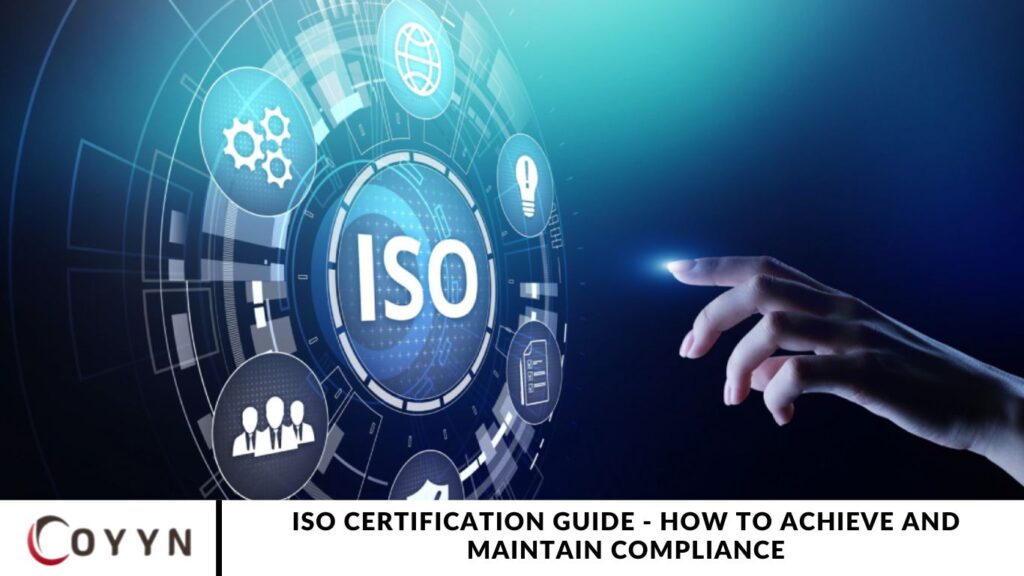Achieving ISO certification strengthens an organization’s credibility, operational efficiency, and market competitiveness. This in-depth guide covers the critical steps to secure and sustain ISO certification, empowering businesses to navigate the certification process with confidence and maintain long-term compliance.
Understanding ISO Certification
Issued by the International Organization for Standardization, ISO certification serves as a global seal of approval, demonstrating a company’s commitment to international standards. These ISO guidelines ensure that products and services meet strict criteria for safety, reliability, and quality. Among the most widely recognized certifications are ISO 9001 for quality management, ISO 14001 for environmental management, and ISO 27001 for information security management. Benefits of ISO Certification
Benefits of ISO Certification
- Improved Quality and Efficiency: Following ISO standards streamlines processes, minimizes errors, and boosts overall product quality.
- Enhanced Customer Satisfaction: Consistently meeting ISO requirements builds stronger customer trust, leading to higher satisfaction and long-term loyalty.
- Global Recognition: ISO certification is respected worldwide, strengthening a company’s reputation and supporting international market expansion.
- Regulatory Compliance: ISO standards often align with legal and regulatory frameworks, making it easier for businesses to maintain compliance.
- Competitive Advantage: ISO certification differentiates a company from competitors, helping attract new clients, partnerships, and business opportunities.
Steps to Achieving ISO Certification
Identify the Appropriate ISO Standard
Begin by selecting the ISO standard that best fits the organization’s goals. For example, companies prioritizing quality management should pursue ISO 9001, while those focused on environmental responsibility may aim for ISO 14001.
Perform a Gap Analysis
Conduct a thorough gap analysis by comparing current processes against the chosen ISO standard’s requirements. This step highlights areas needing improvement to achieve full compliance.
Develop a Strategic Implementation Plan
Using insights from the gap analysis, create a detailed implementation plan outlining the necessary steps, resource allocation, responsibilities, and timelines to meet ISO standards.
Train and Engage Employees
Educating employees is critical to success. Ensure all team members understand the ISO requirements, the importance of compliance, and their roles in the certification journey.
Document All Processes and Procedures
Comprehensive documentation is essential. Maintain clear, accurate records of processes and policies, providing both evidence of compliance and a valuable guide for continuous improvement.
Implement Process Improvements
Put the planned changes into action. This may involve upgrading systems, refining procedures, introducing new technologies, or enhancing current operations to meet ISO criteria.
Conduct Internal Audits
Before pursuing certification, perform internal audits to verify compliance with ISO standards. These audits help identify any lingering gaps or opportunities for fine-tuning processes.
Select a Trusted Certification Body
Choose an accredited certification body to conduct the external audit. A reputable body ensures a credible evaluation and increases the certification’s value and recognition.
Complete the External Certification Audit
The external audit assesses the organization’s documentation, processes, and compliance levels. Upon successful completion, the certification body will issue the ISO certification, confirming the organization’s adherence to international standards.

Maintaining ISO Compliance
Regular Audits
Consistent internal and external audits are crucial for maintaining ISO compliance. Audits verify that processes stay aligned with ISO standards and uncover opportunities for continuous improvement.
Commitment to Continuous Improvement
ISO standards prioritize continuous improvement. Organizations should routinely evaluate and refine their processes to strengthen compliance and boost overall performance.
Employee Training and Awareness Programs
Ongoing employee training and awareness initiatives are essential. Staff must remain updated on ISO standards and revisions and how changes impact their responsibilities.
Management Review and Oversight
Leadership should conduct regular reviews of the organization’s ISO compliance status. Proactive management oversight ensures ongoing commitment to ISO requirements and addresses potential issues before they escalate.
Challenges in Achieving and Maintaining ISO Certification
Resource Allocation
Achieving and sustaining ISO certification demands a careful investment of time, finances, and personnel. Strategic planning and efficient resource allocation are critical for successful certification and long-term compliance.
Managing Resistance to Change
Change can trigger employee resistance, especially when adjusting to new standards. Clear communication, practical training, and substantial leadership help ease transitions and foster a culture of compliance.
Staying Current with ISO Updates
ISO standards evolve to reflect industry advancements. Organizations must actively monitor updates and swiftly adapt their processes to maintain compliance and remain competitive.
Effective Documentation Management
Accurate, up-to-date documentation is vital for ISO compliance. Implementing a robust document management system simplifies recordkeeping, enhances transparency, and supports audit readiness.
Tips for Successful ISO Certification and Compliance
Engage Top Management Early
Top management’s active commitment is essential for achieving and maintaining ISO certification. Their leadership ensures that sufficient resources are allocated and that ISO standards become part of the organization’s core culture. By leading by example and emphasizing quality and compliance, management can inspire employees, drive engagement, and cultivate a workplace focused on continuous improvement.
Build a Culture of Quality and Compliance
Fostering a culture that prioritizes quality and continuous improvement is key to sustaining ISO compliance. Employees must clearly understand the importance of ISO standards and their roles in meeting them. Encouraging open communication, offering regular training sessions, and recognizing outstanding performance can strengthen this culture, boost morale, and reinforce commitment to compliance.
Leverage Technology for Compliance
Implementing technology solutions can significantly simplify the certification and compliance process. Tools such as document management systems, audit software, training platforms, and automated reporting systems enhance operational efficiency, minimize human error, and ensure that records and compliance activities remain current and accurate.
Partner with ISO Certification Experts
Consulting with ISO certification specialists provides organizations with valuable expertise and strategic guidance. These experts can tailor solutions to organizational needs, assist with employee training, conduct internal audits, and support documentation management—helping businesses navigate the certification process more efficiently and effectively.
The Strategic Value of ISO Certification
Achieving ISO certification is a strategic investment that delivers lasting benefits. By adhering to ISO guidelines and maintaining a strong focus on continuous improvement, organizations can enhance operational efficiency, build customer trust, and strengthen market credibility. Ongoing commitment to quality and compliance ensures that businesses not only achieve certification but also sustain it—positioning them for long-term success and global recognition.
ISO compliance best practices for a successful certification
Achieving and sustaining ISO certification requires a commitment to best practices that drive both compliance and continuous improvement.
Strong Leadership and Executive Commitment
Active leadership from top management is vital for ISO certification success. Executives must be deeply involved in the process, providing clear direction, allocating necessary resources, and supporting the implementation of required changes. Their visible commitment sets the tone for the entire organization and reinforces the importance of ISO compliance.
Ongoing Training and Employee Engagement
Continuous employee training and engagement are key pillars of an effective ISO compliance program. Regular training sessions help ensure that all staff members fully understand ISO requirements and recognize their roles in maintaining certification. A well-informed, engaged workforce strengthens compliance and supports a culture of quality.
Comprehensive Documentation and Recordkeeping
Accurate documentation and organized recordkeeping are critical for proving ISO compliance. Every process, procedure, and operational change must be thoroughly documented. Maintaining clear, accessible records not only supports successful audits but also promotes transparency and consistency across the organization.
Frequently Asked Questions
What is ISO certification?
ISO certification verifies that an organization’s processes, products, or services meet internationally recognized standards for quality, safety, efficiency, and reliability set by the International Organization for Standardization (ISO).
Why is ISO certification important for businesses?
ISO certification enhances credibility, boosts customer confidence, improves operational efficiency, facilitates regulatory compliance, and opens opportunities for global trade and partnerships.
Which ISO standard should my organization pursue?
The correct ISO standard depends on your organization’s focus. For example, ISO 9001 targets quality management, ISO 14001 addresses environmental management, and ISO 27001 focuses on information security.
How long does it take to achieve ISO certification?
The timeline varies based on company size, complexity, and readiness. Typically, achieving ISO certification can take between 6 to 18 months from preparation to final audit.
What are the key steps in the ISO certification process?
The main steps include identifying the relevant standard, conducting a gap analysis, developing an implementation plan, training employees, documenting processes, performing internal audits, selecting a certification body, and undergoing an external audit.
How much does ISO certification cost?
Costs vary depending on the size of the organization, the chosen standard, the certification body, and consulting needs. Expenses typically include training, auditing, implementation efforts, and certification fees.
What role does top management play in ISO certification?
Top management must lead the certification efforts by providing strategic direction, ensuring resource allocation, fostering a culture of compliance, and promoting continuous improvement throughout the organization.
Conclusion
Achieving and maintaining ISO certification is a strategic investment that can significantly enhance your organization’s credibility, efficiency, and global competitiveness. By following the essential steps outlined in this guide—such as engaging top management, fostering a culture of quality, leveraging technology, and maintaining rigorous documentation practices—your business can not only obtain ISO certification but also sustain it for long-term success. Continuous improvement, regular audits, and employee engagement are key to ensuring ongoing compliance and adapting to evolving industry standards. Ultimately, ISO certification helps position your organization as a leader in quality and reliability, building trust with customers and partners while driving operational excellence.


